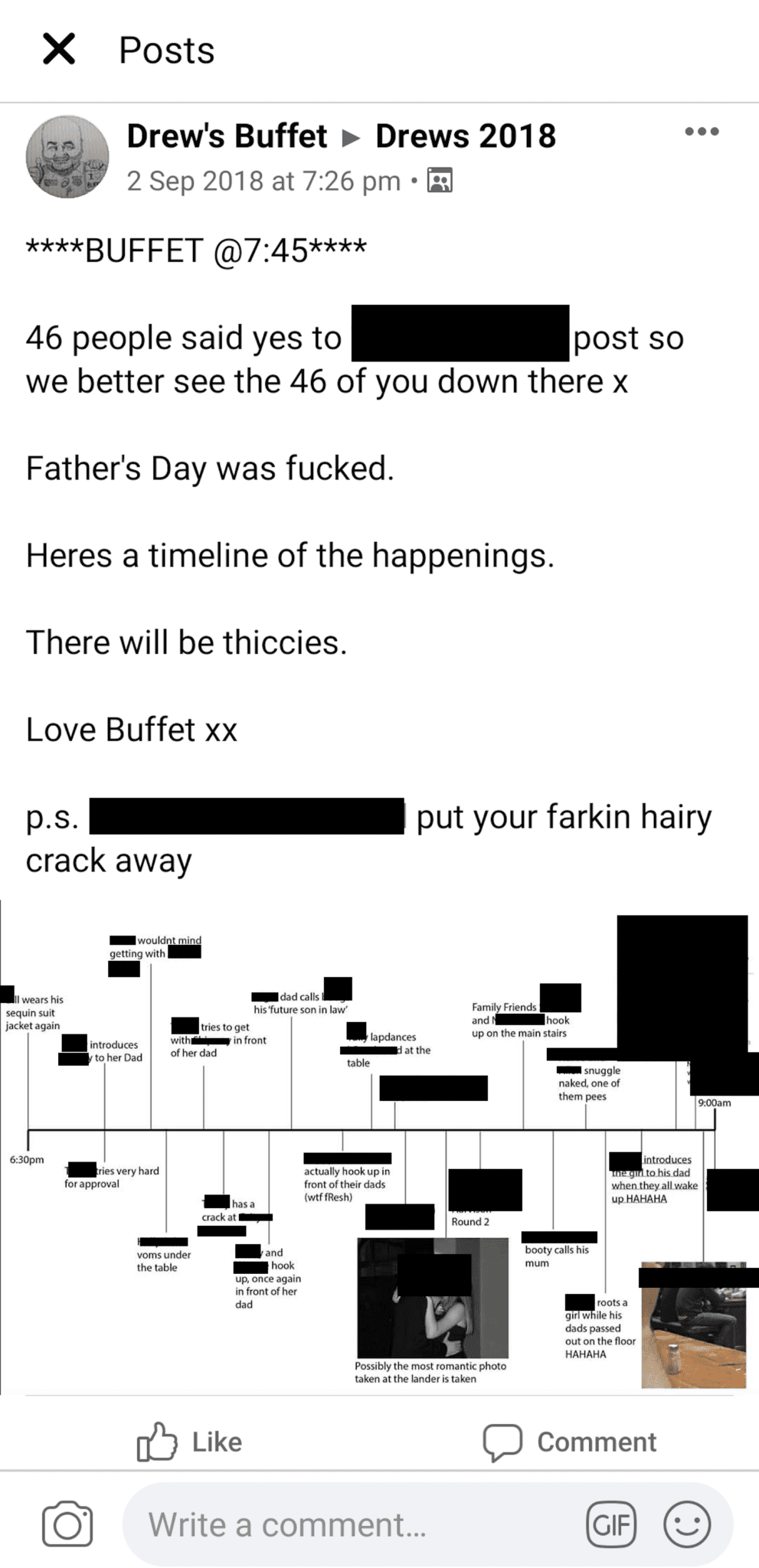Honi can reveal several new allegations of racist, sexist and hazing incidents which have occurred at St Andrew’s College since the Broderick Review into Cultural Renewal at Residential Colleges report was released in late 2017.
Written by former-Sex Discrimination Comissioner Elizabeth Broderick, the review was a million dollar report into sexual violence at the University of Sydney’s residential colleges, with the exception of St Paul’s, who joined on later. Criticised by anti-sexual assault activists for its superficial approach, the report neglected to include case studies or quotes from survivors, and only conducted a small number of interviews with current and former college students. The review failed to mention the scandal-ridden history of the colleges or include the events in 2016 which led in part to the commissioning of the report, including articles from Pulp Media and Honi Soit on Wesley College’s “Rackweb”, St Paul’s “Bone Room” and sexual violence at St Andrew’s itself.
In response to the perceived failings of the Broderick Review, End Rape on Campus Australia published the Red Zone Report in early 2018. The report found that 1 in 12 female St Andrew’s students had experienced attempted or completed rape or sexual assault since commencing — the joint highest rate of all the colleges. Other notable incidents include the words “enter the halls of misogyny” spray painted at the College in 1993, residents advertising their 2006 formal with the slogan “More Moles, More Holes”, and the burning of an LGBTQ pride flag in 2016.
The Broderick Review laid out a number of recommendations for “cultural renewal” at residential colleges, including an end to hazing rituals, the development of a “harm minimisation” alcohol policy and a specific sexual misconduct policy, along with greater gender diversity in student leadership. As a result of the report, St Andrew’s College committed to a “policy of zero tolerance to hazing and sexual misconduct, harmful alcohol, use, harassment and damage to property.” St Andrew’s lists the outcome as being “accomplished” in their 1-year progress report. St Andrew’s Principal, Wayne Erickson, tells Honi that he believes that the college has now implemented all of the Review’s recommendations.
But concerningly, hazing practices known as “walkabout” at St Andrew’s continued after the publication of the Broderick Review. “Walkabout” — a hazing ritual in practice since at least 1997 — involves the auctioning of first year students to second year students. First years are made to kneel on hands and knees during the bidding. Popular students are sold for several hundred dollars, and less popular students are sold for as little as $5. The money is donated to charity.
First year students are then made to perform different tasks for the buyers. One student told Honi that she was made to steal and break street signs. First year students are then forced to drink copious amounts of alcohol, and afterwards are taken to unknown, often remote, areas and left to find their way back home.
Emma* told Honi that in 2018 she was left in rural NSW as part of “walkabout.” The group was allowed only $50 between them, and had to hitchhike back to Sydney. “So it was really demeaning to be auctioned and the event itself was dangerous,” she says.
Post-Broderick Review, participating students were asked to sign a consent form, doing nothing to remove the significant social pressures on students to participate. “Everyone knows that unless you go to Highlanders, unless you drink, unless you participate in group stuff, you’re probably gonna have a shit time at college,” Emma says.
“Getting students to sign consent waivers so that institutional responsibility is abnegated is the very opposite of cultural reform and accountability,” Red Zone Report lead author Nina Funnell tells Honi. “Students should be provided with a safe living environment, not asked to sign waivers accepting that they understand the environment is unsafe.” Though the forms were issued by the Student Club, Emma says that staff were aware of walkabout, and “that sort of thing could not have happened without the greenlight from staff.” Walkabout was cancelled in 2019.
St Andrew’s declined to respond to questions regarding whether hazing rituals still occur within the College, and failed to provide Honi with details as to whether any students had been suspended or expelled from St Andrew’s in the past year.
Other toxic elements of college culture have only become more secretive. Though St Andrew’s has abandoned the “Lolly Buffet” where students announced recent hookups over the college’s PA system (including an instance where an alleged sexual assault was broadcast to the college), similar activity is now run online through a Facebook profile “Drew’s Buffet”. The page posts about recent hook-ups in a closed college resident Facebook group.
For some, a mention by “Drew’s Buffet” is a point of pride. “I know that for a lot of people being tagged by buffet in these posts is almost a cool thing because it shows that the things you’re doing matters and that you matter,” Emma says.
One post, from May 2019, shows results from a poll of the “hottest mums” following a Mother’s Day event at the college. Another, from September 2019, discusses a resident hitting on a 50 year old woman, with college men in the comment thread referring to each other as “tunnel buddies” — a reference to group sex. A separate post from the same month contains a timeline of a previous evening’s events, including the entry “[redacted] roots a girl while his dad is passed out on the floor.”
It’s unclear to what extent the college administration actively monitors the page or the student Facebook groups, but a 2012 post promoting the college’s public Facebook page on the Drew’s Buffet profile from the then-Dean of Students indicates that the administration is at least aware of its existence. St Andrew’s College failed to respond to a question concerning the extent to which the College monitors any students’ Facebook groups.
This is particularly concerning given a history of unsavoury social media use at Sydney University’s residential colleges. The Red Zone Report details a St John’s College ritual called “the Purge” where students were invited to share embarrassing photos of themselves and details of sexual encounters. In 2009, St Paul’s College came under fire for a “pro-rape” Facebook page, and again in 2017 for a Facebook group with sexist posts describing having sex with women as “harpooning whale[s]”.
Though the Broderick Review canvasses harmful uses of social media, reporting that approximately 8% of students at St Andrew’s had witnessed “inappropriate commentary/images/film distributed on social media without consent,” none of its recommendations specifically pertain to social media use.

Honi can also reveal two serious instances of white nationalist sentiment at the College. In one case “white power” was graffitied on a memorial to a deceased St Andrew’s College student. Honi understands that the graffiti was done within the past year. When questioned on whether the College knew about the incident and had investigated it, St Andrew’s Principal Wayne Erickson said, “This has previously not been reported to me…I would be grateful for any information you might have (time and date) which will allow us to investigate it further.”
In another instance, a current St Andrew’s student posted in the college students’ Facebook group saying that she’d lost her guinea pig, and if found it would respond to the name “Adolf”. Honi understands that the student deleted the post after a period of time, but not before other students had “haha” and “love” reacted to it.

Students are also known to defecate, urinate and vomit in common areas of St Andrew’s. This is an expected occurrence after nights at the Highlander and Salisbury (the bars of St Andrew’s and St Paul’s, respectively), and such behaviours occur “pretty frequently.”
A post from May 2019 in a closed college Facebook group shows a video of faeces left in a hallway, with the caption “WARNING: Someone has taken a massive shit on the second floor of main. Watch your step.” The hallways are a common target of faeces, and urine and vomit are often found in the showers. The clean up is left to college staff.
Such behaviour is not isolated to hallways and showers, with students also defecating in the bedrooms of fellow residents. Honi has obtained an image shared in a messenger conversation between two former St Andrew’s students, showing a man, naked from the waist down, who has defecated in the room of a female student and fallen asleep on her floor after she had left her door open overnight.
This behaviour recalls similar instances described in the Red Zone Report, including a 1986 incident where male St Andrew’s students would break into the Women’s College and masturbate in their corridors, to more recent reports of male students ejaculating into the shampoo and body wash bottles of unknowing female residents who would then wash themselves with the semen and product. “These most recent events are appalling, but they are by no means isolated incidents at St Andrew’s,” Funnell says. “There is a long history of sexism, misogyny and racism within the college; it’s like asbestos, it’s in the very walls.”
Emma says that staff responses have been unsatisfactory. “There’s been a lot of complaints from girls to the VP of college regarding the ‘lad’ behaviour of boys,” she says. “But ultimately it just turned into an awkward conversation in the Highlander Bar, post-dinner with the students club to discuss what was inappropriate behaviour.”
These incidents support fears that the Broderick Review would be used as a tick-a-box measure for residential colleges to respond to embarrassing scandals, rather than impetus to engage in the deep structural and cultural reform necessary. Indeed, St Andrew’s appears to have deleted its own Broderick Review report from its website.
Vice-Chancellor Michael Spence, has said that whilst “we’ve made a lot of progress in terms of implementing structural changes to encourage cultural renewal…this doesn’t mean our work is done. Racism and any other form of intimidating, abusive or discriminatory behaviour on our campus is completely unacceptable.” The University, however, was not aware of any of the incidents detailed above. When contacted, Elizabeth Broderick stated that St Andrew’s had not been in contact with her since the Review occurred.
A college culture resistant to change remains. Emma says that students who spoke out against the college in 2016 remain the focus of hatred “even now.” “Ultimately college is a bubble that exists in its own world, distinct from reality. Drew’s survives on secrecy, and denial of its issues.” Despite the platitudes offered by the University of Sydney and St Andrew’s College, it seems that very little has changed at all.
____________________________________________________
If you have any more information on this story, cultural renewal at the colleges more broadly, or anything that you think is in the student interest, please feel free to contact us at editors@honisoit.com. Should you wish to remain anonymous, we will respect that. Alternatively, you can send us an anonymous tip. We only receive your message, and the time and date of submission.
If you are a student at the University of Sydney and you wish to report an instance of sexual assault or misconduct to the university, you can do so through the university’s reporting portal, available on their website. The student liaison officers can be contacted for assistance in this process through their email (safer-communities.officer@sydney.edu.au) or by calling 1800 SYD HLP.
If this article has caused you any distress you can reach out to the following organisations for assistance:
Free counselling through RPA Sexual Assault Clinic , 9515 9040 (Monday to Friday, 8:30am – 5:00pm).
RDVSA NSW Rape Crisis Hotline, 1800 424 017 (24hrs, 7 days)
*Name has been changed.











